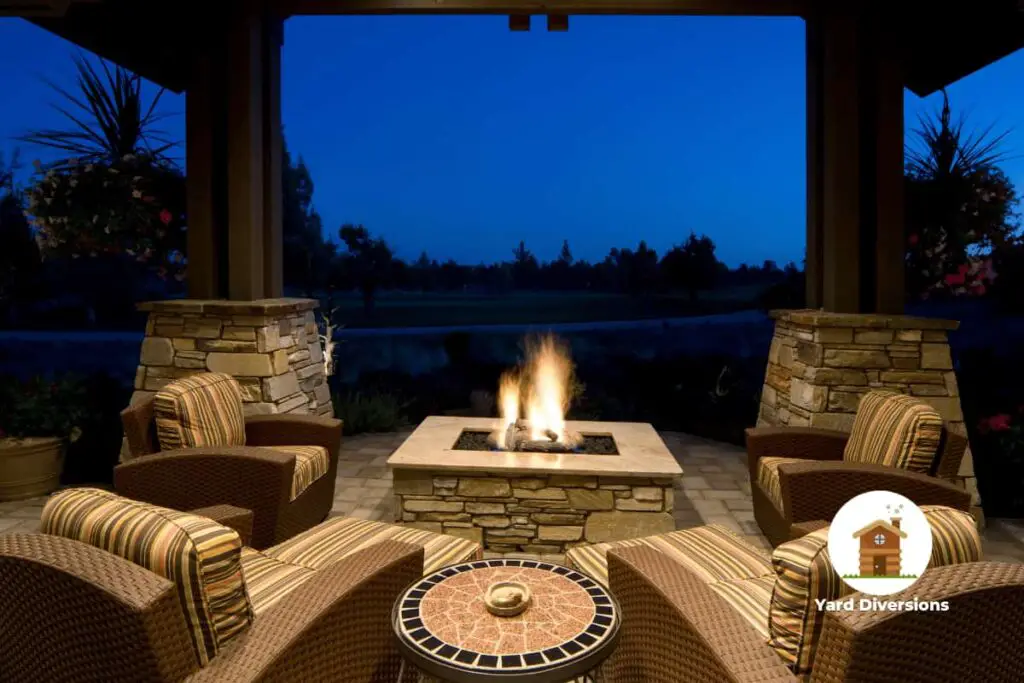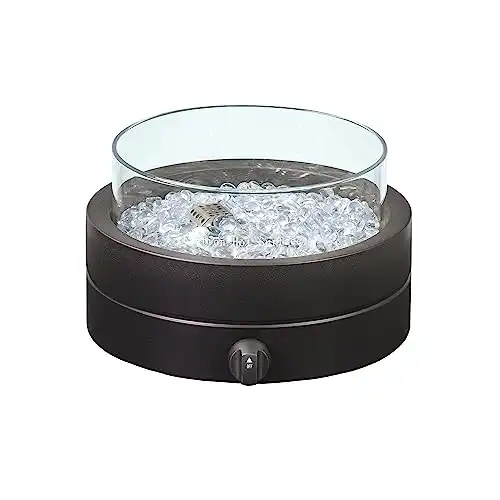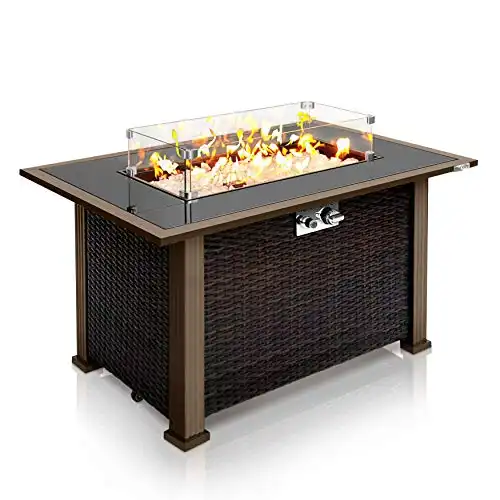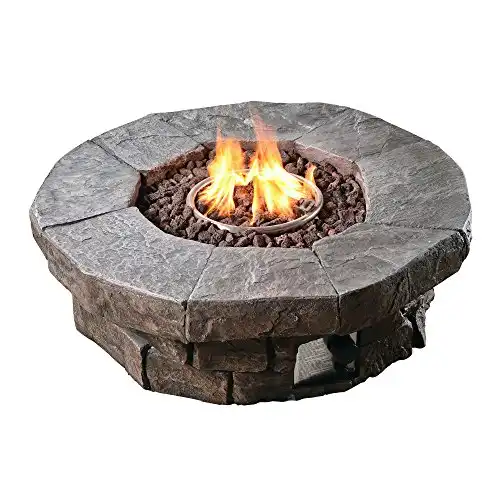If you have a gazebo and a propane fire pit, you might be wondering if it’s safe to use them together. After all, you don’t want to risk damaging your gazebo or endangering yourself and your loved ones. The good news is that you can use a propane fire pit under a gazebo, but there are some important safety considerations to keep in mind.
One of the main concerns with using a propane fire pit under a gazebo is ventilation. Propane fire pits produce carbon monoxide, which can be dangerous if it builds up in an enclosed space. That’s why it’s important to ensure that your gazebo has proper ventilation, such as open windows or a vented roof. Additionally, you should never use a propane fire pit in an enclosed area, such as a tent or a garage, as this can be extremely dangerous.
Another important safety consideration is the type of gazebo you have. Some gazebos are made from flammable materials, such as wood or fabric, which can be a fire hazard if they come into contact with the flames or heat from the fire pit. If you have a flammable gazebo, you should take extra precautions, such as placing the fire pit on a non-flammable surface and keeping a fire extinguisher nearby.
Understanding Propane Fire Pits
If you are considering using a propane fire pit under a gazebo, it is important to understand what a propane fire pit is and how it works. Propane fire pits are outdoor heating appliances that use propane as fuel to produce a flame. They are becoming increasingly popular as they are easy to use, portable, and provide a warm and cozy atmosphere.
Propane is a clean-burning fuel that produces fewer emissions than wood-burning fire pits. Propane fire pits are also easy to start and control, as you can adjust the flame with a knob or switch. Propane fire pits come in various sizes, shapes, and designs, making them a versatile option for any outdoor space.
It is important to note that propane fire pits should only be used in well-ventilated areas, as they produce carbon monoxide. It is also important to follow the manufacturer’s instructions when using a propane fire pit, as improper use can lead to accidents and injuries.
When it comes to fuel, propane fire pits use propane gas, which is stored in a tank that can be easily replaced when empty. Propane tanks come in various sizes, so you can choose the one that best fits your needs.
In summary, propane fire pits are a great option for outdoor heating and can be used under a gazebo. They are easy to use, portable, and produce a warm and cozy atmosphere. However, it is important to use them in well-ventilated areas and follow the manufacturer’s instructions to ensure safe use.
Safety Considerations for Using a Fire Pit Under a Gazebo
If you’re considering using a propane fire pit under a gazebo, safety should be your top priority. While it is generally safe to use a fire pit under a gazebo, there are some important safety considerations that you should keep in mind.
Safety Measures
Here are some safety measures that you should take when using a fire pit under a gazebo:
- Always have a fire extinguisher nearby in case of emergency.
- Keep the fire pit at least 10 feet away from any flammable materials, including the gazebo itself.
- Never leave the fire pit unattended, especially if there are children or pets around.
- Make sure that the fire pit is on a stable surface and that it cannot tip over.
- Follow all safety guidelines and regulations for your specific fire pit and gazebo.
Risks and Accidents
It’s important to be aware of the risks and potential accidents that can occur when using a fire pit under a gazebo. Some of the risks include:
- Fire hazards from sparks or embers escaping the fire pit.
- Carbon monoxide poisoning if the gazebo is enclosed and there is not enough ventilation.
- Burns from touching the hot surfaces of the fire pit or gazebo.
- Damage to the gazebo from the heat generated by the fire pit.
Precautions
To minimize the risks and potential accidents, here are some precautions that you should take when using a fire pit under a gazebo:
- Use a fire screen to contain the sparks and embers from the fire pit.
- Only use a propane fire pit, as it produces less smoke and is less likely to cause carbon monoxide poisoning.
- Install a smoke detector in the gazebo to alert you in case of a fire.
- Check the gazebo for any damage or signs of wear and tear before using the fire pit.
By following these safety measures, precautions, and being aware of the potential risks and accidents, you can safely enjoy using a propane fire pit under your gazebo.
Importance of Ventilation
When using a propane fire pit under a gazebo, proper ventilation is essential to prevent carbon monoxide poisoning and damage to the gazebo. Adequate ventilation ensures that harmful chemicals like carbon monoxide and smoke do not build up in the enclosed space.
Carbon monoxide is a colorless and odorless gas that can be lethal in high concentrations. When a propane fire pit burns, it produces carbon monoxide, which can quickly accumulate in an enclosed space like a gazebo. Without proper ventilation, you may not even realize that you are inhaling this deadly gas.
To prevent carbon monoxide poisoning, it is crucial to ensure that your gazebo has proper ventilation. This can be achieved by installing vents or using a gazebo with an open-air design. Additionally, you should never use a propane fire pit under a closed canopy or tent, as this can trap carbon monoxide and other harmful gases.
Proper ventilation also helps to prevent damage to your gazebo. When a propane fire pit burns, it generates heat, smoke, and embers that need to dissipate. Without proper ventilation, the heat and smoke can damage the gazebo’s walls and ceiling. This can result in discoloration, warping, or even melting of the gazebo’s material.
In summary, proper ventilation is crucial when using a propane fire pit under a gazebo. It helps to prevent carbon monoxide poisoning and damage to the gazebo. Make sure that your gazebo has adequate ventilation and never use a propane fire pit under a closed canopy or tent.
Heat and Fire Risks
When using a propane fire pit under a gazebo, there are some heat and fire risks that you need to be aware of. Propane fire pits are designed to produce heat and flames, which can ignite nearby flammable materials such as wood, fabric, or paper. Here are some of the risks that you should consider before installing a propane fire pit under your gazebo:
- Fire hazards: Propane fire pits produce heat and flames that can ignite nearby flammable materials, such as wood, fabric, or paper. This can result in a fire that can quickly spread and cause significant damage to your gazebo and surrounding areas.
- Embers and sparks: Propane fire pits can also produce embers and sparks, which can fly out of the fire pit and ignite nearby materials. This is especially true if you are using a wood-burning fire pit, as the burning wood can produce more embers and sparks than a gas fire pit.
- Burning materials: If you are using a wood-burning fire pit under your gazebo, the burning wood can produce ashes and debris that can fall onto your gazebo floor or nearby furniture. This can result in burns or damage to your gazebo or furniture.
To minimize the risks associated with using a propane fire pit under your gazebo, there are some safety precautions that you should follow. First, make sure that your fire pit is on a level surface and at least 15-20 feet away from your gazebo. This will help to prevent any embers or sparks from igniting your gazebo or nearby materials.
Second, use a fire pit that is approved for use on wood decks or patios. This will ensure that your fire pit is designed to be used in outdoor spaces and is safe to use under your gazebo.
Finally, place a non-flammable mat under your fire pit to help prevent any burning materials from falling onto your gazebo floor or nearby furniture. This will help to protect your gazebo and surrounding areas from damage and reduce the risk of fire hazards.
By following these safety precautions, you can enjoy the warmth and ambiance of a propane fire pit under your gazebo without putting yourself or your property at risk.
Regulations and Building Codes
When considering installing a propane fire pit under a gazebo, it is important to check with your local regulations and building codes. This will ensure that you are in compliance with any laws or regulations that may be in place to protect public safety.
Local regulations may vary from one jurisdiction to another, so it is important to check with your local authorities to determine what rules apply in your area. Some areas may have restrictions on open flames or specific requirements for outdoor fire features. For example, some municipalities may require that fire pits be located a certain distance from structures or property lines.
Building codes may also come into play when installing a propane fire pit under a gazebo. Building codes are designed to ensure that structures are safe and meet certain minimum standards. Depending on the size and complexity of your gazebo, you may need to obtain a building permit before installing a fire pit.
Before making any decisions, check your local building codes and regulations regarding fire pits and gazebos. Some areas may have restrictions on open flames or specific requirements for outdoor fire features. Some municipalities may require that fire pits be located a certain distance from structures or property lines.
In addition to checking with local authorities, it is also important to follow the manufacturer’s instructions when installing a propane fire pit. This will ensure that the fire pit is installed safely and in accordance with the manufacturer’s specifications.
By following local regulations and building codes, and installing your propane fire pit in accordance with the manufacturer’s instructions, you can enjoy your outdoor living space with peace of mind, knowing that you are in compliance with the law and have taken steps to ensure public safety.
Choosing the Right Location
When it comes to using a propane fire pit under a gazebo, choosing the right location is crucial for safety. Here are some things to consider when selecting a spot for your fire pit:
1. Check local regulations
Before you start, make sure to check your local fire safety regulations. Some states and counties have restrictions on fire pit sizes if they’re to be used under gazebos or pergolas. It’s important to follow these regulations to ensure your safety and avoid any legal issues.
2. Choose a flat, stable surface
Make sure the ground under your gazebo is flat and stable. This will prevent the fire pit from tipping over and causing damage or injury. Avoid using your fire pit on grass or other uneven surfaces.
3. Keep it away from combustible materials
Select a location for your propane fire pit that is at least 10 feet away from any combustible materials, such as trees, shrubs, or buildings. This will reduce the risk of fire and keep you and your property safe.
4. Ensure adequate ventilation
Propane fire pits produce carbon monoxide, so it’s important to ensure adequate ventilation when using them under a gazebo. Make sure there is enough open space around your fire pit to allow for proper airflow.
5. Consider the size of your fire pit
The size of your fire pit is also important when choosing a location. Make sure your gazebo is big enough to accommodate the size of your fire pit. If your gazebo is too small, it can become overcrowded with smoke and heat, making it uncomfortable or even dangerous to use.
By following these tips, you can choose the right location for your propane fire pit under a gazebo and ensure your safety while enjoying your outdoor space.
Clearance and Spacing
When setting up a propane fire pit under a gazebo, it is important to consider the clearance and spacing requirements to ensure safety and prevent any potential hazards. Here are some factors to keep in mind:
Clearance Requirements
The clearance requirements refer to the minimum distance that should be maintained between the fire pit and any surrounding objects. These objects can include the roof of the gazebo, trees, branches, walls, and other flammable materials.
For example, the National Fire Protection Association (NFPA) recommends a minimum clearance of 10 feet between the fire pit and any combustible materials. This includes any overhead structures such as the roof of the gazebo, as well as any nearby trees or branches.
Roof Clearance
When it comes to the roof of the gazebo, it is important to ensure that there is enough clearance to prevent any heat or flames from coming into contact with the roof. This can cause damage to the roof or even start a fire.
The roof clearance requirements will depend on the type of gazebo you have and the manufacturer’s recommendations. However, as a general rule, it is recommended to have at least 24 inches of clearance between the fire pit and the roof of the gazebo.
Wall Clearance
If your gazebo has walls, it is important to ensure that there is enough clearance between the fire pit and the walls. This will prevent any heat or flames from coming into contact with the walls and potentially starting a fire.
The wall clearance requirements will depend on the type of gazebo you have and the manufacturer’s recommendations. However, as a general rule, it is recommended to have at least 36 inches of clearance between the fire pit and any walls.
Height and Distance
The height and distance of the fire pit from the ground should also be considered. It is important to ensure that the fire pit is stable and not at risk of tipping over.
The distance between the fire pit and any nearby objects should also be considered. As mentioned earlier, a minimum clearance of 10 feet is recommended between the fire pit and any combustible materials.
In summary, when setting up a propane fire pit under a gazebo, it is important to consider the clearance and spacing requirements to ensure safety and prevent any potential hazards. Keep in mind the clearance requirements, roof clearance, wall clearance, and the height and distance of the fire pit from the ground.
Fire Pit Materials and Design
When it comes to choosing a fire pit to use under your gazebo, there are several factors to consider, including the materials and design of the fire pit itself.
Firstly, it’s important to consider the type of fire pit you want to use. Traditional wood-burning fire pits can be used under a gazebo, but they require more ventilation and safety precautions than propane or natural gas fire pits. Portable fire pits are also an option, but they require more frequent maintenance and may not be as sturdy as a permanent fire pit.
In terms of materials, metal fire pits are a popular choice due to their durability and heat resistance. However, wood fire pits can also be used, but they require more care and maintenance to prevent damage from the heat and flames. It’s important to choose a fire pit made from high-quality materials that can withstand the heat and weather conditions.
When it comes to the design of the fire pit, it’s important to choose one that is safe and functional. The fire pit should be centered and positioned away from any flammable materials, including the gazebo’s roof, walls, and surrounding structures. It should also be positioned on a stable and level surface to prevent tipping or shifting during use.
In summary, when choosing a fire pit to use under your gazebo, consider the type of fire pit, the materials used, and the design of the fire pit itself. Choose a fire pit that is safe, functional, and made from high-quality materials to ensure a pleasant and safe experience.
Protective Measures and Accessories
When using a propane fire pit under a gazebo, there are several protective measures and accessories you should consider to ensure safety and prevent any potential hazards.
One of the most important accessories to have is a pit mat. A pit mat is a heat-resistant mat that is placed under the fire pit to protect the surface underneath from heat damage. It is essential to choose a mat that is large enough to accommodate the size of your fire pit and gazebo, and made from fire-resistant materials.
Another essential accessory is a fire screen or spark screen. These screens are designed to prevent sparks and embers from flying out of the fire pit and potentially causing a fire. It is crucial to choose a screen that fits snugly over the fire pit and is made from high-quality, heat-resistant materials.
A cover is also an essential accessory to have when using a propane fire pit under a gazebo. A cover will protect the fire pit from rain, snow, and other elements, preventing rust and other damage. It is important to choose a cover that fits the fire pit snugly and is made from durable, weather-resistant materials.
Other protective measures to consider include keeping flammable materials away from the fire pit, ensuring proper ventilation in the gazebo, and using a fire extinguisher in case of an emergency.
Overall, by taking the necessary protective measures and using the right accessories, you can safely enjoy a propane fire pit under your gazebo.
Additional Precautions
When using a propane fire pit under a gazebo, there are some additional precautions you should take to ensure the safety of your guests and property. Here are some things to keep in mind:
Furniture and Flammable Materials
Make sure that any furniture or other flammable materials are at least 10 feet away from the fire pit. This will help prevent accidental fires from sparks or embers that may fly out of the pit.
Plants
If you have plants near your gazebo, make sure they are not too close to the fire pit. Propane fire pits can get very hot, and the heat can damage or even kill nearby plants. Keep plants at least 5 feet away from the fire pit.
Curtains and Fabric Canopy
If your gazebo has curtains or a fabric canopy, make sure they are not too close to the fire pit. Fabric can easily catch fire and spread flames quickly. Keep curtains and fabric at least 5 feet away from the fire pit.
Roof Material
Make sure your gazebo’s roof material is fire-resistant. Some materials, such as thatch or wood shingles, can easily catch fire and spread flames. If your gazebo has a flammable roof material, consider replacing it with a fire-resistant material.
In addition to these precautions, it’s important to always follow the manufacturer’s instructions for your propane fire pit. Make sure you have a fire extinguisher nearby in case of an emergency, and never leave the fire pit unattended. By taking these precautions, you can enjoy your propane fire pit under your gazebo safely and responsibly.
Can I Use a Propane Fire Pit to Thaw a Frozen Outdoor Spigot?
If you find yourself with a frozen outdoor spigot, you might wonder what to do if outdoor spigot is frozen. Using a propane fire pit might seem like a quick solution, but it’s not advisable. The intense heat can cause damage or even start a fire. Instead, try using a hairdryer or applying heat tape to thaw the spigot safely.
Propane Tanks and Storage
When using a propane fire pit under a gazebo, it is important to consider the storage and handling of the propane tank. Here are some safety guidelines and best practices to follow:
Propane Tank Safety
Propane tanks are designed to be safe when used and stored properly. However, they can be dangerous if not handled with care. Here are some dos and don’ts to keep in mind:
- DO store propane tanks outdoors.
- DON’T store propane tanks indoors or in a garage, basement, carport, shed, sunporch, or carport.
- DON’T expose propane tanks to heat over 120˚ Fahrenheit. It may cause a leak or, worse, combustion.
- DO keep propane tanks away from flames and spark-producing tools.
- DON’T store your backup grill tank near the primary tank.
Propane Tank Storage
When storing propane tanks, it is important to keep them in a safe and secure location. Here are some tips for storing propane tanks:
- DO store propane tanks in an upright position.
- DON’T store propane tanks on their sides or upside down.
- DO keep propane tanks away from children and pets.
- DON’T store propane tanks near combustible materials or in direct sunlight.
- DO use a propane tank cover to protect the tank from the elements.
By following these guidelines, you can ensure that your propane tank is stored safely and securely. Always refer to the manufacturer’s instructions for specific guidelines and recommendations.
Is it safe to leave a propane fire pit burning unattended under a gazebo?
When it comes to unattended fire pit safety, it’s important to exercise caution, especially when using a propane fire pit under a gazebo. Leaving a propane fire pit burning unattended under a gazebo can pose serious safety risks. Always make sure to properly extinguish the fire before leaving it unattended.
Conclusion
In conclusion, using a propane fire pit under a gazebo is possible, but it requires careful consideration and adherence to safety guidelines. It is crucial to ensure that your gazebo has proper ventilation and no buildup of smoke or chemicals. Some gazebos have a top opening that acts as a chimney, preventing harmful chemicals like carbon monoxide from building up in your space and causing coughing from smoke and fumes.
If you plan to proceed with placing a fire pit under a gazebo, ensure that the surrounding materials, such as seating and decorative elements, are fire-resistant. Fireproof materials like stone, concrete, or metal can help reduce the risk of accidental fires. It is also recommended to install a fire pit mat or pad to provide an additional layer of protection for your gazebo’s flooring.
Always have a fire extinguisher nearby when using a fire pit under a gazebo. It is also essential to follow the manufacturer’s instructions for your propane fire pit and gazebo to ensure safe and proper use. By taking these precautions, you can enjoy the warmth and ambiance of a fire pit under your gazebo without compromising your safety or the safety of others.





